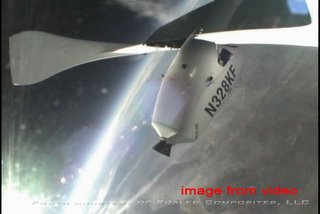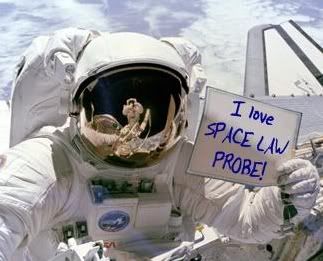1.05.2006
Regulating Rocket Rides
 My Dad, fine lawyer and upstanding gent that he is, doesn't usually sound much like Sploid.
My Dad, fine lawyer and upstanding gent that he is, doesn't usually sound much like Sploid.But last night he took a gander at my hefty printout of the FAA's proposed rulemaking, Human Space Flight Requirements for Crew and Space Flight Participants, and plainly scoffed. "What business is it of the government's if people want to go blow themselves up in rockets?"
Many folks -- lawyers and others -- would agree with the sentiment. But Dad envisions small group of folks getting together in remote places who like to play rocket equation games and experiment with their own bodies as projectiles. He just doesn't see commercial human space flight as an industry.
And yes, it does appear the FAA has put a lot of time and effort into regulating a segment of the economy that consists of exactly one company. (OK, two, if you include XCOR, which as the FAA notes, is also licensed to perform launches with humans on board. But only Scaled Composites has actually used theirs.) The FAA estimates that five to six companies will successfully enter the human space flight industry in the next ten years. Which sounds like serious business to me. (How many airlines do we have in the U.S.?)
Overall, I think the proposal reflects a reasonable balance from regulators who are carefully working through the Commercial Space Launch Amendments Act of 2004's (CSLAA) mandate to protect public safety with requirements that do not unduly burden this nascent industry.
(By the way, at least the 30-page Federal Register entry for the proposed rulemaking does not look quite as bad the 124-page unpublished version, which appeared first, and many people referenced initially.)
Reactions to the NPRM? Round up the usual supporters and detractors. Of course, regulation will cost too much, drive business out of the U.S. and kill the industry. Naturally, regulation will establish the government's seriousness about commercial human space flight and boost the credentials of the industry.
I looked at the comments already submitted and posted on DOT's docket (four, at last count). I'll do a roundup of those later. But already the submissions reflect both ends of the spectrum of opinion. From the side that wants the feds to back off, Dennis Dupuis objects to the pilot licensing provision, writing in that, "Orville & Wilbur Wright did not have pilot licenses, yet they did just fine." And for the folks who want more oversight and would go even further than the NPRM, finding no mention of EVA activity, and noting that a passenger "can easily decide to throw something at earth that might pose public risk," David Deutsch calls on the FAA to impose "fines and penalties for leaving uncontrolled satalites [sic] near earth's orbit." It's like Crossfire over there.
By the way, if you comment, be careful about disclosing to the government any proprietary or confidential info because (unless you request otherwise) it will all get published. And there is plenty to comment on if you feel like it.
I don't mind the requirement that each crew member possess and carry an FAA second class airman medical certificate issued in accordance with 14 CFR part 67 and issued within 12 months prior to launch or reentry, and also that there is no medical requirement for space flight participants. (But maybe some folks like the idea of the government mandating medical testing of private citizens participating in commercial activities?)
As to informed consent of space flight participants provision (§460.45, which goes farther than the statute, 49 U.S.C. 70105(b)(5)(A)), what can we say? They know that we all know that they darn well know what they are getting into.
The financial responsibility provisions (Part 440) -- insurance, waivers, government payment of excess third-party liability claims, etc., are a treat to read and if someone pays me, I will go through them in a lot more depth than I did after work last night during the Rose Bowl. (But first I will admit right here on SLP that I know even less about waivers and reciprocal waivers and things like that than I do about football.)
That "no-fly list" issue is already sending up red flags. For the record, it's not in the proposed amendment, but in the discussion of the security requirements, the NPRM reads, "The FAA notes that one means of satisfying part of this requirement would be for an operator to consult the 'no-fly' list of the Transportation Security Administration." (Does anyone really support the idea of a no-orbit list?)
In contrast to the security issue (including the prohibition against space flight participants carrying weapons on board), some things that worry the FAA do sound kinda quaint. Rocket engineers understand all the devilish engineering details, but I was surprised to see the extent of the FAA's concerns about "fog." Apparently, and there is no indication that Congressional hearings were held, but the government has determined that given "a flight crew depended on visual information through a window, humidity control would be necessary to avoid windows fogging and condensation that can hinder the pilot's vision." I don't know. It's a spaceship. If you can build one, you understand condensation without the government having to explain it to you.
(In any case, I don't hesitate to point out here that my reading of the Federal Register section in question reveals no mention of a certain exciting on board activity some space tourism enthusiasts have proposed, and which I have talked about here, that could fog up the spacecraft's windows for sure. Ahem. So far, no rule against that in space.)
So how much will all this regulation cost space flight companies? You have a right to ask, and under the Paperwork Reduction Act, the feds have to estimate at least the burden of recordkeeping. For purposes of its analysis here, the FAA uses the mid-point between its high and low cost scenarios (which are based on estimates ranging from one to more than 100 space flights annually) and calculates "the proposed rulemaking would take 2,975.05 hours per year, costing $206,469 annually."
(Those hours could certainly launch the careers of a few young space lawyers. But not at the skimpy hourly rate the FAA appears to be using of about $69.)
Not to mention what the added paper pushing will cost taxpayers (because government lawyers have to get paid, too). Using again the "mid-point" between the high and low end scenarios, the FAA says the proposed rulemaking would take 1,522.3 hours per year, costing $79,221 annually.
And what about the cost per mission of industry compliance with the proposed rule? The Regulatory Flexibilty Act calls for an analysis of the impact, and here the FAA, while specifically inviting comment on this issue, make its own "extremely speculative" calculations, estimating that "costs to perform 10,142 missions (upper bound) over ten years are $2,739,149 or an average of $270 per mission."
Really? Where I come from, nothing costs $270. That won't buy a space company half an hour of legal services, even at a fraction of Peter Pettibone's rates, it won't even pay for sandwiches and coffee during crew training. And you'd have to be using an Etch-A-Sketch as a space flight simulator.
The FAA offers no calculus for what these rules might save commercial space business. How much value does the industry gain from a new perception of safety? Might it sell more rides? (But then gain, what about the lost business as thrill seeking customers who prefer unregulated risk go climb Everest instead?)
In the end, what should the feds rightly do about the dangers of space tourism? I agree with Professor Reynolds who writes, "Protecting the 'uninvolved public' -- those who simply don't want to find themselves underneath crashing rockets -- is a proper role for the government.
As the space tourism industry grows, obviously a body of law will grow around it. (So Dad, relax, and go watch the NFL; there's not much government regulation in football.
Although, hey, there sure are a lot of rules.)






